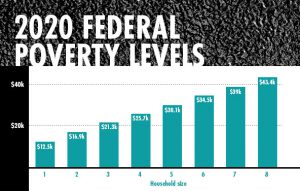Medicare and Medicaid are two government-run health care programs. The two programs sound similar, but they are far from it. They serve different people, and are both operated and funded by different parts within the government. It’s easy to confuse the two; they even sound similar, but there are different requirements for each program, and who they cover.

Medicare
Medicare is a federal insurance program that provides health coverage for people 65 and older. It is not based on income, and it is not free. In order to be eligible for Medicare, you must meet some requirements:
- You must be 65 and older.
- You must have worked and paid at least 40 qualifying quarters, or 10 years, of Medicare taxes to receive Medicare Part A.
- You must be a U.S. citizen.
Medicare Part A covers hospitalization, and is free as long as you have paid 10 years of necessary Medicare taxes. Medicare Part B covers doctor visits and outpatient care.
Medicare will cover 80% of your Part B expenses, leaving you with 20% to pay out of pocket. If the expenses get to be too much to budget, you can look into additional coverage to pay for the 20%, such as Medicare Supplement plans. These plans vary by premium, deductible, and coverage. Additionally, they are helpful to those who travel, as some cover international health care costs.
Medicaid
Medicaid is a government assistance program that is available in every state and is for individuals and families with low income. The income must be below 100% of the poverty line. Medicaid is typically free since most people receiving it have little to no assets. In rare cases, individuals are expected to copay.

Medicaid covers:
- Hospitalizations
- home health care
- doctor visits
- labs
- x-rays
- preventive services
- maternity and pediatric services
It will cover individuals and families, and if you have a disability, you might be eligible.
The Differences
Eligibility:
Medicare is typically for seniors 65 and older, and cannot be used for families. Medicaid is based on income, while Medicare is based on age and how many years you paid taxes in the U.S. while working.
Enrollment:
In order to enroll into Medicare, you must be within 3 months of your 65th birthday, and 3 months after your 65th birthday. It totals to 7 months when you include your birthday month. Medicare’s annual enrollment is from October 15 to December 7 and is when you can make changes to your plan.
Medicaid does not have an open enrollment period, you can just sign up anytime you are eligible (meaning below the poverty line).
Options:

Medicare has many options you can choose from. For example, you can choose a Supplement plan to help pay for Part B expenses. There are about 10 different Supplement Plans to choose from, making it easier to cover more of what you need, and gives you more control of how much you spend. There are different premiums, out-of-pocket costs, and deductibles for each plan.
Medicaid, on the other hand, has very few options to choose from.
If you are in the market for a Medicare Supplement plan, we can help. EZ.Insure has trained agents in the industry that will provide you with quotes on all the different plans, and which suits your needs and budget mist. The agent will go over each plan, and even sign you up when you are ready- for free. We can help you get started when you are ready to sign up for Medicare, or just have questions on how to save money, or how to get more coverage. To get started, contact an agent at 888-350-1890, or email us at [email protected]. You can also get instant quotes by entering your zip code in the bar above, it’s that simple. No hassle, no obligation.
